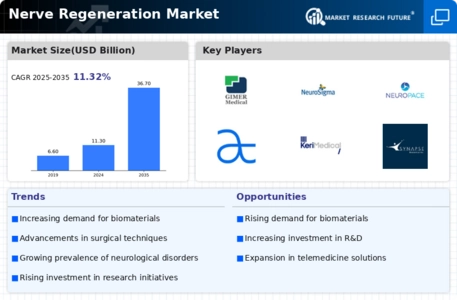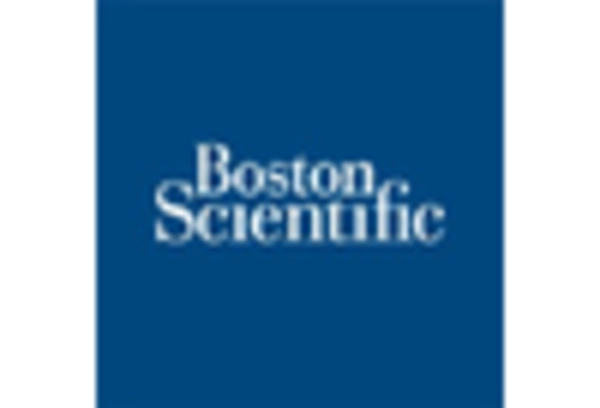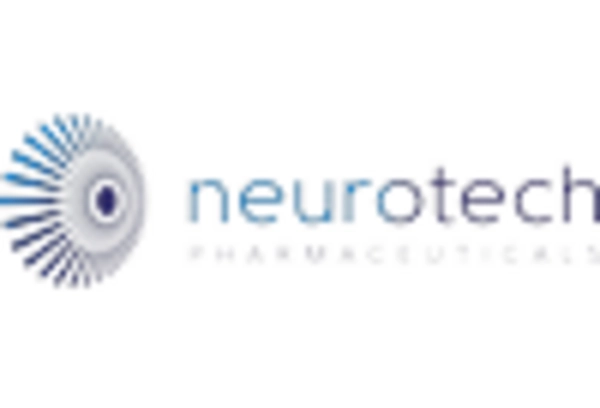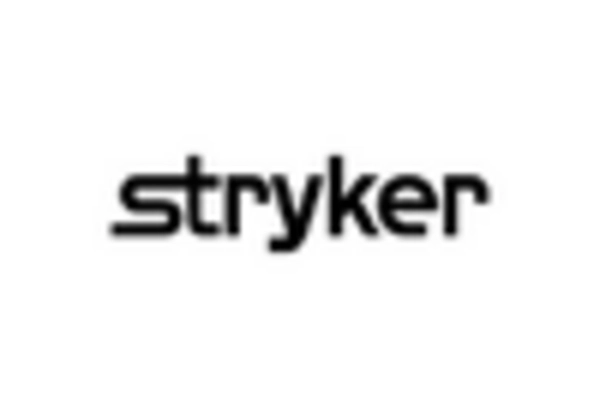-
Market Introduction
-
Definition 17
-
Scope of the Study 17
-
Market Structure 17
-
Research Methodology
-
Research Process 18
-
Primary Research 19
-
Secondary Research 20
-
Market Size Estimation 21
-
Forecast Model 21
-
Market Dynamics
-
Introduction 22
-
Drivers 23
- Rising Neurological Disorders 23
- Increasing Geriatric Population 23
- Technological Advancements 23
-
Restraints 24
- Stringent Regulatory Framework 24
- High Cost 24
-
Opportunity 24
- Entering Developing Economies 24
-
Market Factor Analysis
-
Value Chain Analysis 25
- Research and Development 25
- Manufacturing 25
- Distribution & Sales 26
- Post-Sales Monitoring 26
-
Porter’s Five Forces Model 27
- Threat of New Entrants 27
- Bargaining Power of Suppliers 27
- Bargaining Power of Buyers 28
- Threat of Substitutes 28
- Intensity of Rivalry 28
-
Pricing Analysis 29
-
Global Nerve Regeneration Market, by Product
-
Introduction 30
-
Neurostimulation and Neuromodulation Devices 32
- Internal Neurostimulation Devices 33
- External Neurostimulation Devices 34
-
Biomaterials 35
-
Global Nerve Regeneration Market, by Application
-
Introduction 37
-
Neurostimulation and Neuromodulation Surgeries 39
-
Direct Nerve Repair/Neurorrhaphy 41
-
Nerve Grafting 42
-
Stem Cell Therapy 43
-
Global Nerve Regeneration Market, by End User
-
Introduction 44
-
Hospitals and Clinics 45
-
Ambulatory Surgery Centers 46
-
Global Nerve Regeneration Market, by Region
-
Overview 47
-
Americas 48
- North America 53
- South America 67
-
Europe 72
- Western Europe 77
- Eastern Europe 109
-
ASIA–PACIFIC 114
- China 119
- Japan 124
- India 128
- South Korea 133
- Australia 137
- Rest of Asia-Pacific 142
-
Middle East & Africa 147
- Middle East 152
- Africa 157
-
Company Landscape
-
Company Share Analysis 162
-
Company Profile
-
Boston Scientific Corporation 164
- Company Overview 164
- Financial Overview 164
- Products/Services Offered 165
- Key Developments 165
- SWOT Analysis 166
- Key Strategies 166
-
LivaNova PLC 167
- Company Overview 167
- Financial Overview 167
- Products/Services Offered 168
- Key Developments 168
- SWOT Analysis 168
- Key Strategies 168
-
Axogen Corporation 169
- Company Overview 169
- Financial Overview 169
- Products/Services Offered 169
- Key Developments 170
- SWOT Analysis 170
- Key Strategies 170
-
-
Integra LifeSciences 171
- Company Overview 171
- Financial Overview 171
- Products/Services Offered 172
- Key Developments 173
- SWOT Analysis 173
- Key Strategies 173
-
Abbott 174
- Company Overview 174
- Financial Overview 174
- Products/Services Offered 175
- Key Developments 175
- SWOT Analysis 175
- Key Strategies 176
-
Stryker Corporation 177
- Company Overview 177
- Financial Overview 177
- Products/Services Offered 178
- Key Developments 178
- SWOT Analysis 178
- Key Strategies 179
-
Nuvectra Corporation 180
- Company Overview 180
- Financial Overview 180
- Products/Services Offered 180
- Key Developments 181
- SWOT Analysis 181
- Key Strategies 181
-
NeuroPace 182
- Company Overview 182
- Financial Overview 182
- Products/Services Offered 182
- Key Developments 182
- SWOT Analysis 183
- Key Strategies 183
-
Polyganics 184
- Company Overview 184
- Financial Overview 184
- Products/Services Offered 184
- Key Developments 184
- SWOT Analysis 185
- Key Strategies 185
-
Medtronic 186
- Company Overview 186
- Financial Overview 186
- Products/Services Offered 187
- Key Developments 187
- SWOT Analysis 188
- Key Strategies 188
-
Appendix
-
References 189
-
Related Reports 189
-
List of Tables
-
GLOBALNERVE REGENERATION MARKET, BY PRODUCT, 2023–2030 (USD MILLION) 31
-
GLOBAL NERVE REGENERATION MARKET, FOR NEUROSTIMULATION AND NEUROMODULATION DEVICES, BY TYPE,
-
GLOBAL NERVE REGENERATION MARKET FOR NEUROSTIMULATION AND NEUROMODULATION DEVICES, BY REGION,
-
GLOBAL NERVE REGENERATION MARKET, FOR INTERNAL NEUROSTIMULATION DEVICES, BY TYPE, 2023–2030 (USD MILLION) 33
-
GLOBAL NERVE REGENERATION MARKET, FOR EXTERNAL NEUROSTIMULATION DEVICES, BY TYPE, 2023–2030 (USD MILLION) 34
-
GLOBAL NERVE REGENERATION MARKET, FOR BIOMATERIALS, BY TYPE, 2023–2030 (USD MILLION) 35
-
GLOBAL NERVE REGENERATION MARKET FOR BIOMATERIALS, BY REGION, 2023–2030 (USD MILLION) 36
-
GLOBAL NERVE REGENERATION MARKET, BY APPLICATION, 2023–2030 (USD MILLION) 38
-
GLOBAL NERVE REGENERATION MARKET, FOR NEUROSTIMULATION AND NEUROMODULATION SURGERIES, BY TYPE,
-
GLOBAL NERVE REGENERATION MARKET FOR NEUROSTIMULATION AND NEUROMODULATION SURGERIES, BY REGION,
-
GLOBAL NERVE REGENERATION MARKET FOR DIRECT NERVE REPAIR/NEURORRHAPHY, BY REGION,
-
GLOBAL NERVE REGENERATION MARKET, FOR NERVE GRAFTING, BY TYPE, 2023–2030 (USD MILLION) 42
-
GLOBAL NERVE REGENERATION MARKET FOR NERVE GRAFTING, BY REGION, 2023–2030 (USD MILLION) 42
-
GLOBAL NERVE REGENERATION MARKET FOR STEM CELL THERAPY, BY REGION, 2023–2030 (USD MILLION) 43
-
GLOBAL NERVE REGENERATION MARKET, BY END USER, 2023–2030 (USD MILLION) 44
-
GLOBAL NERVE REGENERATION MARKET FOR HOSPITALS & CLINICS, BY REGION, 2023–2030 (USD MILLION) 45
-
GLOBAL NERVE REGENERATION MARKET FOR AMBULATORY SURGERY CENTERS, BY REGION, 2023–2030 (USD MILLION) 46
-
GLOBAL NERVE REGENERATION MARKET, BY REGION, 2023–2030 (USD MILLION) 47
-
AMERICAS: NERVE REGENERATION MARKET, BY REGION, 2023–2030 (USD MILLION) 48
-
AMERICAS: NERVE REGENERATION MARKET, BY PRODUCT, 2023–2030 (USD MILLION) 49
-
AMERICAS: NERVE REGENERATION MARKET, FOR NEUROSTIMULATION AND NEUROMODULATION DEVICES, BY TYPE,
-
AMERICAS: NERVE REGENERATION MARKET, FOR INTERNAL NEUROSTIMULATION DEVICES, BY TYPE,
-
AMERICAS: NERVE REGENERATION MARKET, FOR EXTERNAL NEUROSTIMULATION DEVICES, BY TYPE,
-
AMERICAS: NERVE REGENERATION MARKET, FOR BIOMATERIALS, BY TYPE, 2023–2030 (USD MILLION) 51
-
AMERICAS: NERVE REGENERATION MARKET, BY APPLICATION, 2023–2030 (USD MILLION) 51
-
AMERICAS: NERVE REGENERATION MARKET, FOR NEUROSTIMULATION AND NEUROMODULATION SURGERIES, BY TYPE,
-
AMERICAS: NERVE REGENERATION MARKET, FOR NERVE GRAFTING, BY TYPE, 2023–2030 (USD MILLION) 52
-
AMERICAS: NERVE REGENERATION MARKET, BY END USER, 2023–2030 (USD MILLION) 53
-
NORTH AMERICA: NERVE REGENERATION MARKET, BY COUNTRY, 2023–2030 (USD MILLION) 53
-
NORTH AMERICA: NERVE REGENERATION MARKET, BY PRODUCT, 2023–2030 (USD MILLION) 54
-
NORTH AMERICA: NERVE REGENERATION MARKET, FOR NEUROSTIMULATION AND NEUROMODULATION DEVICES, BY TYPE,
-
NORTH AMERICA: NERVE REGENERATION MARKET, FOR INTERNAL NEUROSTIMULATION DEVICES, BY TYPE,
-
NORTH AMERICA: NERVE REGENERATION MARKET, FOR EXTERNAL NEUROSTIMULATION DEVICES, BY TYPE,
-
NORTH AMERICA: NERVE REGENERATION MARKET, FOR BIOMATERIALS, BY TYPE, 2023–2030 (USD MILLION) 56
-
NORTH AMERICA: NERVE REGENERATION MARKET, BY APPLICATION, 2023–2030 (USD MILLION) 56
-
NORTH AMERICA: NERVE REGENERATION MARKET, FOR NEUROSTIMULATION AND NEUROMODULATION SURGERIES, BY TYPE, 2023–2030 (USD MILLION) 57
-
NORTH AMERICA: NERVE REGENERATION MARKET, FOR NERVE GRAFTING, BY TYPE, 2023–2030 (USD MILLION) 57
-
NORTH AMERICA: NERVE REGENERATION MARKET, BY END USER, 2023–2030 (USD MILLION) 58
-
US: NERVE REGENERATION MARKET, BY PRODUCT, 2023–2030 (USD MILLION) 58
-
US: NERVE REGENERATION MARKET, FOR NEUROSTIMULATION AND NEUROMODULATION DEVICES, BY TYPE,
-
US: NERVE REGENERATION MARKET, FOR INTERNAL NEUROSTIMULATION DEVICES, BY TYPE, 2023–2030 (USD MILLION) 59
-
US: NERVE REGENERATION MARKET, FOR EXTERNAL NEUROSTIMULATION DEVICES, BY TYPE, 2023–2030 (USD MILLION) 60
-
US: NERVE REGENERATION MARKET, FOR BIOMATERIALS, BY TYPE, 2023–2030 (USD MILLION) 60
-
US: NERVE REGENERATION MARKET, BY APPLICATION, 2023–2030 (USD MILLION) 61
-
US: NERVE REGENERATION MARKET, FOR NEUROSTIMULATION AND NEUROMODULATION SURGERIES, BY TYPE,
-
US: NERVE REGENERATION MARKET, FOR NERVE GRAFTING, BY TYPE, 2023–2030 (USD MILLION) 62
-
US: NERVE REGENERATION MARKET, BY END USER, 2023–2030 (USD MILLION) 62
-
CANADA: NERVE REGENERATION MARKET, BY PRODUCT, 2023–2030 (USD MILLION) 63
-
CANADA: NERVE REGENERATION MARKET, FOR NEUROSTIMULATION AND NEUROMODULATION DEVICES, BY TYPE,
-
CANADA: NERVE REGENERATION MARKET, FOR INTERNAL NEUROSTIMULATION DEVICES, BY TYPE,
-
CANADA: NERVE REGENERATION MARKET, FOR EXTERNAL NEUROSTIMULATION DEVICES, BY TYPE,
-
CANADA: NERVE REGENERATION MARKET, FOR BIOMATERIALS, BY TYPE, 2023–2030 (USD MILLION) 65
-
CANADA: NERVE REGENERATION MARKET, BY APPLICATION, 2023–2030 (USD MILLION) 65
-
CANADA: NERVE REGENERATION MARKET, FOR NEUROSTIMULATION AND NEUROMODULATION SURGERIES, BY TYPE,
-
CANADA: NERVE REGENERATION MARKET, FOR NERVE GRAFTING, BY TYPE, 2023–2030 (USD MILLION) 66
-
CANADA: NERVE REGENERATION MARKET, BY END USER, 2023–2030 (USD MILLION) 67
-
SOUTH AMERICA: NERVE REGENERATION MARKET, BY PRODUCT, 2023–2030 (USD MILLION) 67
-
SOUTH AMERICA: NERVE REGENERATION MARKET, FOR NEUROSTIMULATION AND NEUROMODULATION DEVICES, BY TYPE,
-
SOUTH AMERICA: NERVE REGENERATION MARKET, FOR INTERNAL NEUROSTIMULATION DEVICES, BY TYPE,
-
SOUTH AMERICA: NERVE REGENERATION MARKET, FOR EXTERNAL NEUROSTIMULATION DEVICES, BY TYPE,
-
SOUTH AMERICA: NERVE REGENERATION MARKET, FOR BIOMATERIALS, BY TYPE, 2023–2030 (USD MILLION) 69
-
SOUTH AMERICA: NERVE REGENERATION MARKET, BY APPLICATION, 2023–2030 (USD MILLION) 70
-
SOUTH AMERICA: NERVE REGENERATION MARKET, FOR NEUROSTIMULATION AND NEUROMODULATION SURGERIES, BY TYPE, 2023–2030 (USD MILLION) 70
-
SOUTH AMERICA: NERVE REGENERATION MARKET, FOR NERVE GRAFTING, BY TYPE, 2023–2030 (USD MILLION) 71
-
SOUTH AMERICA: NERVE REGENERATION MARKET, BY END USER, 2023–2030 (USD MILLION) 71
-
EUROPE: NERVE REGENERATION MARKET, BY REGION, 2023–2030 (USD MILLION) 72
-
EUROPE: NERVE REGENERATION MARKET, BY PRODUCT, 2023–2030 (USD MILLION) 73
-
EUROPE: NERVE REGENERATION MARKET, FOR NEUROSTIMULATION AND NEUROMODULATION DEVICES, BY TYPE,
-
EUROPE: NERVE REGENERATION MARKET, FOR INTERNAL NEUROSTIMULATION DEVICES, BY TYPE, 2023–2030 (USD MILLION) 74
-
EUROPE: NERVE REGENERATION MARKET, FOR EXTERNAL NEUROSTIMULATION DEVICES, BY TYPE,
-
EUROPE: NERVE REGENERATION MARKET, FOR BIOMATERIALS, BY TYPE, 2023–2030 (USD MILLION) 75
-
EUROPE: NERVE REGENERATION MARKET, BY APPLICATION, 2023–2030 (USD MILLION) 75
-
EUROPE: NERVE REGENERATION MARKET, FOR NEUROSTIMULATION AND NEUROMODULATION SURGERIES, BY TYPE,
-
EUROPE: NERVE REGENERATION MARKET, FOR NERVE GRAFTING, BY TYPE, 2023–2030 (USD MILLION) 76
-
EUROPE: NERVE REGENERATION MARKET, BY END USER, 2023–2030 (USD MILLION) 77
-
WESTERN EUROPE: NERVE REGENERATION MARKET, BY COUNTRY, 2023–2030 (USD MILLION) 77
-
WESTERN EUROPE: NERVE REGENERATION MARKET, BY PRODUCT, 2023–2030 (USD MILLION) 78
-
WESTERN EUROPE: NERVE REGENERATION MARKET, FOR NEUROSTIMULATION AND NEUROMODULATION DEVICES,
-
BY TYPE, 2023–2030 (USD MILLION) 78
-
WESTERN EUROPE: NERVE REGENERATION MARKET, FOR INTERNAL NEUROSTIMULATION DEVICES, BY TYPE,
-
WESTERN EUROPE: NERVE REGENERATION MARKET, FOR EXTERNAL NEUROSTIMULATION DEVICES, BY TYPE,
-
WESTERN EUROPE: NERVE REGENERATION MARKET, FOR BIOMATERIALS, BY TYPE, 2023–2030 (USD MILLION) 80
-
WESTERN EUROPE: NERVE REGENERATION MARKET, BY APPLICATION, 2023–2030 (USD MILLION) 80
-
WESTERN EUROPE: NERVE REGENERATION MARKET, FOR NEUROSTIMULATION AND NEUROMODULATION SURGERIES,
-
BY TYPE, 2023–2030 (USD MILLION) 81
-
WESTERN EUROPE: NERVE REGENERATION MARKET, FOR NERVE GRAFTING, BY TYPE, 2023–2030 (USD MILLION) 81
-
WESTERN EUROPE: NERVE REGENERATION MARKET, BY END USER, 2023–2030 (USD MILLION) 82
-
GERMANY: NERVE REGENERATION MARKET, BY PRODUCT, 2023–2030 (USD MILLION) 82
-
GERMANY: NERVE REGENERATION MARKET, FOR NEUROSTIMULATION AND NEUROMODULATION DEVICES, BY TYPE,
-
GERMANY: NERVE REGENERATION MARKET, FOR INTERNAL NEUROSTIMULATION DEVICES, BY TYPE,
-
GERMANY: NERVE REGENERATION MARKET, FOR EXTERNAL NEUROSTIMULATION DEVICES, BY TYPE,
-
GERMANY: NERVE REGENERATION MARKET, FOR BIOMATERIALS, BY TYPE, 2023–2030 (USD MILLION) 84
-
GERMANY: NERVE REGENERATION MARKET, BY APPLICATION, 2023–2030 (USD MILLION) 85
-
GERMANY: NERVE REGENERATION MARKET, FOR NEUROSTIMULATION AND NEUROMODULATION SURGERIES, BY TYPE,
-
GERMANY: NERVE REGENERATION MARKET, FOR NERVE GRAFTING, BY TYPE, 2023–2030 (USD MILLION) 86
-
GERMANY: NERVE REGENERATION MARKET, BY END USER, 2023–2030 (USD MILLION) 86
-
FRANCE: NERVE REGENERATION MARKET, BY PRODUCT, 2023–2030 (USD MILLION) 87
-
FRANCE: NERVE REGENERATION MARKET, FOR NEUROSTIMULATION AND NEUROMODULATION DEVICES, BY TYPE,
-
FRANCE: NERVE REGENERATION MARKET, FOR INTERNAL NEUROSTIMULATION DEVICES, BY TYPE,
-
FRANCE: NERVE REGENERATION MARKET, FOR EXTERNAL NEUROSTIMULATION DEVICES, BY TYPE,
-
FRANCE: NERVE REGENERATION MARKET, FOR BIOMATERIALS, BY TYPE, 2023–2030 (USD MILLION) 89
-
FRANCE: NERVE REGENERATION MARKET, BY APPLICATION, 2023–2030 (USD MILLION) 89
-
FRANCE: NERVE REGENERATION MARKET, FOR NEUROSTIMULATION AND NEUROMODULATION SURGERIES, BY TYPE,
-
FRANCE: NERVE REGENERATION MARKET, FOR NERVE GRAFTING, BY TYPE, 2023–2030 (USD MILLION) 90
-
FRANCE: NERVE REGENERATION MARKET, BY END USER, 2023–2030 (USD MILLION) 91
-
ITALY: NERVE REGENERATION MARKET, BY PRODUCT, 2023–2030 (USD MILLION) 91
-
ITALY: NERVE REGENERATION MARKET, FOR NEUROSTIMULATION AND NEUROMODULATION DEVICES, BY TYPE,
-
ITALY: NERVE REGENERATION MARKET, FOR INTERNAL NEUROSTIMULATION DEVICES, BY TYPE, 2023–2030 (USD MILLION) 92
-
ITALY: NERVE REGENERATION MARKET, FOR EXTERNAL NEUROSTIMULATION DEVICES, BY TYPE, 2023–2030 (USD MILLION) 93
-
ITALY: NERVE REGENERATION MARKET, FOR BIOMATERIALS, BY TYPE, 2023–2030 (USD MILLION) 93
-
ITALY: NERVE REGENERATION MARKET, BY APPLICATION, 2023–2030 (USD MILLION) 94
-
ITALY: NERVE REGENERATION MARKET, FOR NEUROSTIMULATION AND NEUROMODULATION SURGERIES, BY TYPE,
-
ITALY: NERVE REGENERATION MARKET, FOR NERVE GRAFTING, BY TYPE, 2023–2030 (USD MILLION) 95
-
ITALY: NERVE REGENERATION MARKET, BY END USER, 2023–2030 (USD MILLION) 95
-
SPAIN: NERVE REGENERATION MARKET, BY PRODUCT, 2023–2030 (USD MILLION) 96
-
SPAIN: NERVE REGENERATION MARKET, FOR NEUROSTIMULATION AND NEUROMODULATION DEVICES, BY TYPE,
-
SPAIN: NERVE REGENERATION MARKET, FOR INTERNAL NEUROSTIMULATION DEVICES, BY TYPE, 2023–2030 (USD MILLION) 97
-
SPAIN: NERVE REGENERATION MARKET, FOR EXTERNAL NEUROSTIMULATION DEVICES, BY TYPE, 2023–2030 (USD MILLION) 97
-
SPAIN: NERVE REGENERATION MARKET, FOR BIOMATERIALS, BY TYPE, 2023–2030 (USD MILLION) 98
-
SPAIN: NERVE REGENERATION MARKET, BY APPLICATION, 2023–2030 (USD MILLION) 98
-
SPAIN: NERVE REGENERATION MARKET, FOR NEUROSTIMULATION AND NEUROMODULATION SURGERIES, BY TYPE,
-
SPAIN: NERVE REGENERATION MARKET, FOR NERVE GRAFTING, BY TYPE, 2023–2030 (USD MILLION) 99
-
SPAIN: NERVE REGENERATION MARKET, BY END USER, 2023–2030 (USD MILLION) 100
-
UK: NERVE REGENERATION MARKET, BY PRODUCT, 2023–2030 (USD MILLION) 100
-
UK: NERVE REGENERATION MARKET, FOR NEUROSTIMULATION AND NEUROMODULATION DEVICES, BY TYPE,
-
UK: NERVE REGENERATION MARKET, FOR INTERNAL NEUROSTIMULATION DEVICES, BY TYPE, 2023–2030 (USD MILLION) 101
-
UK: NERVE REGENERATION MARKET, FOR EXTERNAL NEUROSTIMULATION DEVICES, BY TYPE, 2023–2030 (USD MILLION) 102
-
UK: NERVE REGENERATION MARKET, FOR BIOMATERIALS, BY TYPE, 2023–2030 (USD MILLION) 102
-
UK: NERVE REGENERATION MARKET, BY APPLICATION, 2023–2030 (USD MILLION) 103
-
UK: NERVE REGENERATION MARKET, FOR NEUROSTIMULATION AND NEUROMODULATION SURGERIES, BY TYPE,
-
UK: NERVE REGENERATION MARKET, FOR NERVE GRAFTING, BY TYPE, 2023–2030 (USD MILLION) 104
-
UK: NERVE REGENERATION MARKET, BY END USER, 2023–2030 (USD MILLION) 104
-
REST OF WESTERN EUROPE: NERVE REGENERATION MARKET, BY PRODUCT, 2023–2030 (USD MILLION) 105
-
REST OF WESTERN EUROPE: NERVE REGENERATION MARKET, FOR NEUROSTIMULATION AND NEUROMODULATION DEVICES,
-
BY TYPE, 2023–2030 (USD MILLION) 105
-
REST OF WESTERN EUROPE: NERVE REGENERATION MARKET, FOR INTERNAL NEUROSTIMULATION DEVICES, BY TYPE,
-
REST OF WESTERN EUROPE: NERVE REGENERATION MARKET, FOR EXTERNAL NEUROSTIMULATION DEVICES, BY TYPE,
-
REST OF WESTERN EUROPE: NERVE REGENERATION MARKET, FOR BIOMATERIALS, BY TYPE, 2023–2030 (USD MILLION) 107
-
REST OF WESTERN EUROPE: NERVE REGENERATION MARKET, BY APPLICATION, 2023–2030 (USD MILLION) 107
-
REST OF WESTERN EUROPE: NERVE REGENERATION MARKET, FOR NEUROSTIMULATION AND NEUROMODULATION
-
SURGERIES, BY TYPE, 2023–2030 (USD MILLION) 108
-
REST OF WESTERN EUROPE: NERVE REGENERATION MARKET, FOR NERVE GRAFTING, BY TYPE, 2023–2030 (USD MILLION) 108
-
REST OF WESTERN EUROPE: NERVE REGENERATION MARKET, BY END USER, 2023–2030 (USD MILLION) 109
-
EASTERN EUROPE: NERVE REGENERATION MARKET, BY PRODUCT, 2023–2030 (USD MILLION) 109
-
EASTERN EUROPE: NERVE REGENERATION MARKET, FOR NEUROSTIMULATION AND NEUROMODULATION DEVICES,
-
BY TYPE, 2023–2030 (USD MILLION) 110
-
EASTERN EUROPE: NERVE REGENERATION MARKET, FOR INTERNAL NEUROSTIMULATION DEVICES, BY TYPE,
-
EASTERN EUROPE: NERVE REGENERATION MARKET, FOR EXTERNAL NEUROSTIMULATION DEVICES, BY TYPE,
-
EASTERN EUROPE: NERVE REGENERATION MARKET, FOR BIOMATERIALS, BY TYPE, 2023–2030 (USD MILLION) 111
-
EASTERN EUROPE: NERVE REGENERATION MARKET, BY APPLICATION, 2023–2030 (USD MILLION) 112
-
EASTERN EUROPE: NERVE REGENERATION MARKET, FOR NEUROSTIMULATION AND NEUROMODULATION SURGERIES,
-
BY TYPE, 2023–2030 (USD MILLION) 112
-
EASTERN EUROPE: NERVE REGENERATION MARKET, FOR NERVE GRAFTING, BY TYPE, 2023–2030 (USD MILLION) 113
-
EASTERN EUROPE: NERVE REGENERATION MARKET, BY END USER, 2023–2030 (USD MILLION) 113
-
ASIA–PACIFIC: NERVE REGENERATION MARKET, BY COUNTRY, 2023–2030 (USD MILLION) 114
-
ASIA–PACIFIC: NERVE REGENERATION MARKET, BY PRODUCT, 2023–2030 (USD MILLION) 115
-
ASIA–PACIFIC: NERVE REGENERATION MARKET, FOR NEUROSTIMULATION AND NEUROMODULATION DEVICES, BY TYPE,
-
ASIA–PACIFIC: NERVE REGENERATION MARKET, FOR INTERNAL NEUROSTIMULATION DEVICES, BY TYPE,
-
ASIA–PACIFIC: NERVE REGENERATION MARKET, FOR EXTERNAL NEUROSTIMULATION DEVICES, BY TYPE,
-
ASIA–PACIFIC: NERVE REGENERATION MARKET, FOR BIOMATERIALS, BY TYPE, 2023–2030 (USD MILLION) 117
-
ASIA–PACIFIC: NERVE REGENERATION MARKET, BY APPLICATION, 2023–2030 (USD MILLION) 117
-
ASIA–PACIFIC: NERVE REGENERATION MARKET, FOR NEUROSTIMULATION AND NEUROMODULATION SURGERIES, BY TYPE,
-
ASIA–PACIFIC: NERVE REGENERATION MARKET, FOR NERVE GRAFTING, BY TYPE, 2023–2030 (USD MILLION) 118
-
ASIA–PACIFIC: NERVE REGENERATION MARKET, BY END USER, 2023–2030 (USD MILLION) 119
-
CHINA: NERVE REGENERATION MARKET, BY PRODUCT, 2023–2030 (USD MILLION) 119
-
CHINA: NERVE REGENERATION MARKET, FOR NEUROSTIMULATION AND NEUROMODULATION DEVICES, BY TYPE,
-
CHINA: NERVE REGENERATION MARKET, FOR INTERNAL NEUROSTIMULATION DEVICES, BY TYPE, 2023–2030 (USD MILLION) 120
-
CHINA: NERVE REGENERATION MARKET, FOR EXTERNAL NEUROSTIMULATION DEVICES, BY TYPE, 2023–2030 (USD MILLION) 121
-
CHINA: NERVE REGENERATION MARKET, FOR BIOMATERIALS, BY TYPE, 2023–2030 (USD MILLION) 121
-
CHINA: NERVE REGENERATION MARKET, BY APPLICATION, 2023–2030 (USD MILLION) 122
-
CHINA: NERVE REGENERATION MARKET, FOR NEUROSTIMULATION AND NEUROMODULATION SURGERIES, BY TYPE,
-
CHINA: NERVE REGENERATION MARKET, FOR NERVE GRAFTING, BY TYPE, 2023–2030 (USD MILLION) 123
-
CHINA: NERVE REGENERATION MARKET, BY END USER, 2023–2030 (USD MILLION) 123
-
JAPAN: NERVE REGENERATION MARKET, BY PRODUCT, 2023–2030 (USD MILLION) 124
-
JAPAN: NERVE REGENERATION MARKET, FOR NEUROSTIMULATION AND NEUROMODULATION DEVICES, BY TYPE,
-
JAPAN: NERVE REGENERATION MARKET, FOR INTERNAL NEUROSTIMULATION DEVICES, BY TYPE, 2023–2030 (USD MILLION) 125
-
JAPAN: NERVE REGENERATION MARKET, FOR EXTERNAL NEUROSTIMULATION DEVICES, BY TYPE, 2023–2030 (USD MILLION) 125
-
JAPAN: NERVE REGENERATION MARKET, FOR BIOMATERIALS, BY TYPE, 2023–2030 (USD MILLION) 126
-
JAPAN: NERVE REGENERATION MARKET, BY APPLICATION, 2023–2030 (USD MILLION) 126
-
JAPAN: NERVE REGENERATION MARKET, FOR NEUROSTIMULATION AND NEUROMODULATION SURGERIES, BY TYPE,
-
JAPAN: NERVE REGENERATION MARKET, FOR NERVE GRAFTING, BY TYPE, 2023–2030 (USD MILLION) 127
-
JAPAN: NERVE REGENERATION MARKET, BY END USER, 2023–2030 (USD MILLION) 128
-
INDIA: NERVE REGENERATION MARKET, BY PRODUCT, 2023–2030 (USD MILLION) 128
-
INDIA: NERVE REGENERATION MARKET, FOR NEUROSTIMULATION AND NEUROMODULATION DEVICES, BY TYPE,
-
INDIA: NERVE REGENERATION MARKET, FOR INTERNAL NEUROSTIMULATION DEVICES, BY TYPE, 2023–2030 (USD MILLION) 129
-
INDIA: NERVE REGENERATION MARKET, FOR EXTERNAL NEUROSTIMULATION DEVICES, BY TYPE, 2023–2030 (USD MILLION) 130
-
INDIA: NERVE REGENERATION MARKET, FOR BIOMATERIALS, BY TYPE, 2023–2030 (USD MILLION) 130
-
INDIA: NERVE REGENERATION MARKET, BY APPLICATION, 2023–2030 (USD MILLION) 131
-
INDIA: NERVE REGENERATION MARKET, FOR NEUROSTIMULATION AND NEUROMODULATION SURGERIES, BY TYPE,
-
INDIA: NERVE REGENERATION MARKET, FOR NERVE GRAFTING, BY TYPE, 2023–2030 (USD MILLION) 132
-
INDIA: NERVE REGENERATION MARKET, BY END USER, 2023–2030 (USD MILLION) 132
-
REPUBLIC OF KOREA: NERVE REGENERATION MARKET, BY PRODUCT, 2023–2030 (USD MILLION) 133
-
REPUBLIC OF KOREA: NERVE REGENERATION MARKET, FOR NEUROSTIMULATION AND NEUROMODULATION DEVICES,
-
BY TYPE, 2023–2030 (USD MILLION) 133
-
REPUBLIC OF KOREA: NERVE REGENERATION MARKET, FOR INTERNAL NEUROSTIMULATION DEVICES, BY TYPE,
-
REPUBLIC OF KOREA: NERVE REGENERATION MARKET, FOR EXTERNAL NEUROSTIMULATION DEVICES, BY TYPE,
-
REPUBLIC OF KOREA: NERVE REGENERATION MARKET, FOR BIOMATERIALS, BY TYPE, 2023–2030 (USD MILLION) 135
-
REPUBLIC OF KOREA: NERVE REGENERATION MARKET, BY APPLICATION, 2023–2030 (USD MILLION) 135
-
REPUBLIC OF KOREA: NERVE REGENERATION MARKET, FOR NEUROSTIMULATION AND NEUROMODULATION SURGERIES,
-
BY TYPE, 2023–2030 (USD MILLION) 136
-
REPUBLIC OF KOREA: NERVE REGENERATION MARKET, FOR NERVE GRAFTING, BY TYPE, 2023–2030 (USD MILLION) 136
-
REPUBLIC OF KOREA: NERVE REGENERATION MARKET, BY END USER, 2023–2030 (USD MILLION) 137
-
AUSTRALIA: NERVE REGENERATION MARKET, BY PRODUCT, 2023–2030 (USD MILLION) 137
-
AUSTRALIA: NERVE REGENERATION MARKET, FOR NEUROSTIMULATION AND NEUROMODULATION DEVICES, BY TYPE,
-
AUSTRALIA: NERVE REGENERATION MARKET, FOR INTERNAL NEUROSTIMULATION DEVICES, BY TYPE,
-
AUSTRALIA: NERVE REGENERATION MARKET, FOR EXTERNAL NEUROSTIMULATION DEVICES, BY TYPE,
-
AUSTRALIA: NERVE REGENERATION MARKET, FOR BIOMATERIALS, BY TYPE, 2023–2030 (USD MILLION) 139
-
AUSTRALIA: NERVE REGENERATION MARKET, BY APPLICATION, 2023–2030 (USD MILLION) 140
-
AUSTRALIA: NERVE REGENERATION MARKET, FOR NEUROSTIMULATION AND NEUROMODULATION SURGERIES, BY TYPE,
-
AUSTRALIA: NERVE REGENERATION MARKET, FOR NERVE GRAFTING, BY TYPE, 2023–2030 (USD MILLION) 141
-
AUSTRALIA: NERVE REGENERATION MARKET, BY END USER, 2023–2030 (USD MILLION) 141
-
REST OF ASIA PACIFIC: NERVE REGENERATION MARKET, BY PRODUCT, 2023–2030 (USD MILLION) 142
-
REST OF ASIA PACIFIC: NERVE REGENERATION MARKET, FOR NEUROSTIMULATION AND NEUROMODULATION DEVICES,
-
BY TYPE, 2023–2030 (USD MILLION) 142
-
REST OF ASIA PACIFIC: NERVE REGENERATION MARKET, FOR INTERNAL NEUROSTIMULATION DEVICES, BY TYPE,
-
REST OF ASIA PACIFIC: NERVE REGENERATION MARKET, FOR EXTERNAL NEUROSTIMULATION DEVICES, BY TYPE,
-
REST OF ASIA PACIFIC: NERVE REGENERATION MARKET, FOR BIOMATERIALS, BY TYPE, 2023–2030 (USD MILLION) 144
-
REST OF ASIA PACIFIC: NERVE REGENERATION MARKET, BY APPLICATION, 2023–2030 (USD MILLION) 144
-
REST OF ASIA PACIFIC: NERVE REGENERATION MARKET, FOR NEUROSTIMULATION AND NEUROMODULATION SURGERIES,
-
BY TYPE, 2023–2030 (USD MILLION) 145
-
REST OF ASIA PACIFIC: NERVE REGENERATION MARKET, FOR NERVE GRAFTING, BY TYPE, 2023–2030 (USD MILLION) 145
-
REST OF ASIA PACIFIC: NERVE REGENERATION MARKET, BY END USER, 2023–2030 (USD MILLION) 146
-
MIDDLE EAST & AFRICA: NERVE REGENERATION MARKET, BY REGION, 2023–2030 (USD MILLION) 147
-
MIDDLE EAST & AFRICA: NERVE REGENERATION MARKET, BY PRODUCT, 2023–2030 (USD MILLION) 148
-
MIDDLE EAST & AFRICA: NERVE REGENERATION MARKET, FOR NEUROSTIMULATION AND NEUROMODULATION DEVICES,
-
BY TYPE, 2023–2030 (USD MILLION) 148
-
MIDDLE EAST & AFRICA: NERVE REGENERATION MARKET, FOR INTERNAL NEUROSTIMULATION DEVICES, BY TYPE,
-
MIDDLE EAST & AFRICA: NERVE REGENERATION MARKET, FOR EXTERNAL NEUROSTIMULATION DEVICES, BY TYPE,
-
MIDDLE EAST & AFRICA: NERVE REGENERATION MARKET, FOR BIOMATERIALS, BY TYPE, 2023–2030 (USD MILLION) 150
-
MIDDLE EAST & AFRICA: NERVE REGENERATION MARKET, BY APPLICATION, 2023–2030 (USD MILLION) 150
-
MIDDLE EAST & AFRICA: NERVE REGENERATION MARKET, FOR NEUROSTIMULATION AND NEUROMODULATION
-
SURGERIES, BY TYPE, 2023–2030 (USD MILLION) 151
-
MIDDLE EAST & AFRICA: NERVE REGENERATION MARKET, FOR NERVE GRAFTING, BY TYPE, 2023–2030 (USD MILLION) 151
-
MIDDLE EAST & AFRICA: NERVE REGENERATION MARKET, BY END USER, 2023–2030 (USD MILLION) 152
-
MIDDLE EAST: NERVE REGENERATION MARKET, BY PRODUCT, 2023–2030 (USD MILLION) 152
-
MIDDLE EAST: NERVE REGENERATION MARKET, FOR NEUROSTIMULATION AND NEUROMODULATION DEVICES, BY TYPE,
-
MIDDLE EAST: NERVE REGENERATION MARKET, FOR INTERNAL NEUROSTIMULATION DEVICES, BY TYPE,
-
MIDDLE EAST: NERVE REGENERATION MARKET, FOR EXTERNAL NEUROSTIMULATI

















Leave a Comment